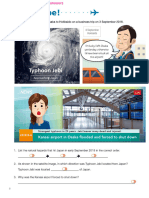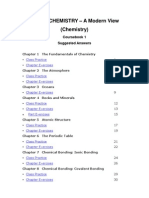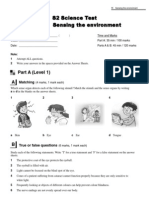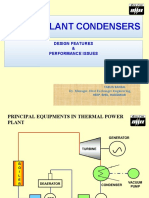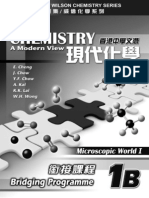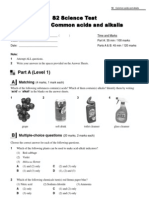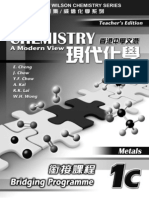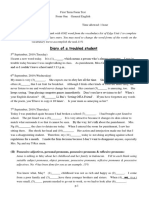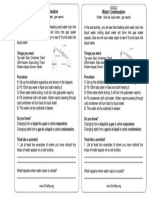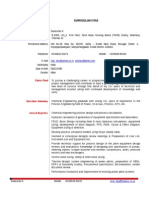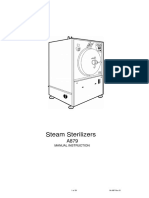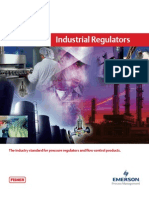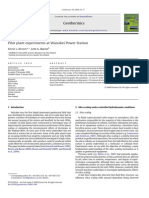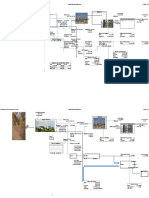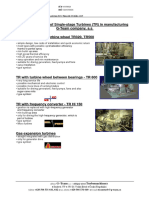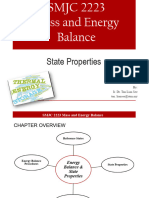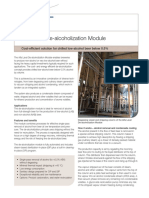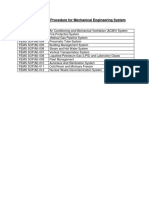(Unit 2) Water 水
(Unit 2) Water 水
Uploaded by
Lai Chuen ChanCopyright:
Available Formats
(Unit 2) Water 水
(Unit 2) Water 水
Uploaded by
Lai Chuen ChanCopyright
Available Formats
Share this document
Did you find this document useful?
Is this content inappropriate?
Copyright:
Available Formats
(Unit 2) Water 水
(Unit 2) Water 水
Uploaded by
Lai Chuen ChanCopyright:
Available Formats
2 Water
水
2.1 The water cycle 水循環
1. Water can exist in three physical states: solid (ice), liquid (water) or gas (water
vapour or steam).
水以三種物態存於地球:固體 (冰)、液體 (水) 或氣體 (水汽或蒸汽)。
2. The table below shows some changes in the states of water.
下表展示一些水的物態變化。
Absorbs or Temperature
Process Change in state
releases energy? remains unchanged?
過程 物態變化
吸收 / 釋出能量 温度是否維持不變?
ice (solid) water (liquid)
冰 (固體) 水 (液體)
Melting Absorbs energy Yes
熔化 吸收能量 是
Ice begins to melt at 0 C
(the melting point of ice).
在 0 C (冰的熔點) 時,冰
開始熔化成水。
water (liquid) ice (solid)
水 (液體) 冰 (固體)
Freezing Releases energy Yes
凝固 釋出能量 是
When water is cooled to 0 C
(the freezing point of water),
it freezes and changes to ice.
當水冷卻至 0 C (水的凝固
點) 時,水會凝固成冰。
Aristo Science for the New Century 雅集科學新世紀
© Aristo Educational Press Ltd. 2018 © 雅集出版社有限公司 2018
-1-
Quick Revision Notes 快速温習錦囊
Unit 2 單元 2
Absorbs or Temperature
Process Change in state
releases energy? remains unchanged?
過程 物態變化
吸收 / 釋出能量 温度是否維持不變?
water (liquid) steam (gas)
水 (液體) 蒸汽 (氣體)
Boiling Absorbs energy Yes
沸騰 吸收能量 是
When water is heated to
100 C (the boiling point of
water), it changes to steam.
當水加熱至 100 C (水的沸
點) 時,會轉變成蒸汽。
3. When water evaporates, it absorbs energy and changes to water vapour.
Evaporation of water can take place at any temperature.
水蒸發時,會吸收能量並轉變成水汽。水的蒸發可在任何温度下發生。
Wet clothes become dry as
water evaporates.
濕衣服變乾是由於衣服內
的水分蒸發。
4. Water can change its state from gas to liquid through condensation.
水可以藉凝結由氣體轉變成液體。
water droplets
水點
When water vapour in air comes into
contact with a colder surface, such as the
outside of a cold drink, it condenses into
water droplets.
當空氣中的水汽接觸到較冷的表面 (例
如一罐凍飲的表面) 時,會凝結成水。
Aristo Science for the New Century 雅集科學新世紀
© Aristo Educational Press Ltd. 2018 © 雅集出版社有限公司 2018
-2-
Quick Revision Notes 快速温習錦囊
Unit 2 單元 2
water droplets
水點
Steam condenses on the cold surface of the
glass lid and forms water droplets.
蒸汽接觸到較冷的玻璃煲蓋表面時,會
凝結成水。
5. The changes in the states of water are summarized below.
以下總結了水的物態變化。
boiling / evaporation (at any temperature)
melting 沸騰 / 蒸發 (在任何温度下)
熔化
ice (solid) water (liquid) steam or water vapour (gas)
冰 (固體) 水 (液體) 蒸汽或水汽 (氣體)
freezing
凝固 condensation
凝結
absorbs energy 吸收能量
releases energy 釋出能量
6. The water cycle keeps the total water on Earth constant. The water cycle
involves the following processes.
水循環維持地球上水的總存量恆常不變。以下是水循環的主要過程。
Water evaporates to become
water vapour. Then, it is
carried upwards by warm air.
水受熱蒸發成水汽,隨暖空氣
上升到空中。
Water in seas, rivers, etc. Water vapour cools and
absorbs energy from the Sun. Water cycle condenses, forming clouds.
海洋、河流中的水吸收了太陽 水循環 水汽遇冷凝結成小水點,積聚
的能量。 成雲。
Water droplets fall from clouds
as rain, snow or hail.
雲裏的小水點變重,下降成
雨、雪或冰雹。
Aristo Science for the New Century 雅集科學新世紀
© Aristo Educational Press Ltd. 2018 © 雅集出版社有限公司 2018
-3-
Quick Revision Notes 快速温習錦囊
Unit 2 單元 2
E 7. The rate of evaporation increases when
在以下情況,水的蒸發速率會增加:
the temperature is higher.
温度較高。
the humidity is lower.
濕度較低。
there is more airflow.
空氣流通。
the surface area exposed is larger.
暴露的面積較大。
2.2 Dissolving 溶解
8. When a substance dissolves in a liquid, a solution is formed. The substance that
dissolves is called a solute. The liquid in which the substance dissolves is called
a solvent.
物質在液體中溶解形成溶液,溶於液體中的物質稱為溶質,而溶解物質的液
體則稱為溶劑。
sugar (solute)
糖 (溶質)
sugar solution
water (solution)
(solvent) 糖溶液
水 (溶劑) (溶液)
Sugar (solute) dissolves in water (solvent) to form sugar solution (solution).
糖 (溶質) 在水 (溶劑) 中溶解後形成糖溶液 (溶液)。
9. Water is called the universal solvent because it can dissolve many different
substances. However, there are some substances that water cannot dissolve.
水被稱為通用溶劑,因它能溶解多種不同的物質。然而,仍有一些物質是不
可溶於水的。
Aristo Science for the New Century 雅集科學新世紀
© Aristo Educational Press Ltd. 2018 © 雅集出版社有限公司 2018
-4-
Quick Revision Notes 快速温習錦囊
Unit 2 單元 2
10. The table below summarizes soluble substances and insoluble substances in
water:
下表總結可溶於水的物質和不可溶於水的物質。
Soluble substances in water Insoluble substances in water
可溶於水的物質 不可溶於水的物質
Description They can dissolve in water. They cannot dissolve in water.
描述 它們可溶於水中。 它們不可溶於水中。
sugar 糖 corn flour 粟粉
Example
salt 食鹽 rice 米
例子
jelly powder 啫喱粉 soil 泥
11. The rate of dissolving increases when
在以下情況,溶解速率會增加:
the solution is stirred.
溶液被攪拌。
the temperature of the solvent is higher.
溶劑的温度較高。
the surface area of the solute is larger.
溶質的表面積較大。
E 12. Solubility is the limited amount of a solute which can dissolve in a given amount
of solvent.
溶解度是指固定分量的溶劑只能溶解某個限量的溶質。
E 13. Different substances have different solubilities in water. For example, sugar has
a higher solubility in water than table salt and copper(II) sulphate.
在相同分量的水中,不同的物質各有不同的溶解度。例如:糖在水中的溶解
度較食鹽和硫酸銅(II) 的高。
E 14. The solubility of a substance in water changes with temperature.
物質的溶解度會隨温度而改變。
Aristo Science for the New Century 雅集科學新世紀
© Aristo Educational Press Ltd. 2018 © 雅集出版社有限公司 2018
-5-
Quick Revision Notes 快速温習錦囊
Unit 2 單元 2
2.3 Water purification 水的淨化
15. Water is essential for life on Earth. All forms of life contain water. For example,
water makes up about 70% of our body weight. It makes up about 50% of the
weight of trees.
水對我們以至所有生物都十分重要。所有生物體內均含有水。例如人體內的
水約佔其體重的70%,樹木內的水約佔其重量的50%。
16. Water is widely used in our daily life. For example, we use water for washing,
cooking, crop irrigation, production of paper and clothes.
水在我們的日常生活中用途廣泛。例如,我們用水來清潔、煮食、灌溉農作
物、製造紙張和衣服等。
17. Natural water contains soluble impurities, insoluble impurities and
microorganisms.
天然水含有可溶的雜質、不可溶的雜質和微生物。
Description 描述 Example 例子
Soluble Impurities They can dissolve in water.
可溶的雜質 它們可溶於水中。
salt 鹽
Insoluble impurities They cannot dissolve in water.
不可溶的雜質 它們不可溶於水中。
leaves sand mud
葉 沙 泥
Aristo Science for the New Century 雅集科學新世紀
© Aristo Educational Press Ltd. 2018 © 雅集出版社有限公司 2018
-6-
Quick Revision Notes 快速温習錦囊
Unit 2 單元 2
Description 描述 Example 例子
They can only be seen with
a microscope.
用顯微鏡才能觀察到它們。
E.coli often cause diarrhoeal Amoeba
500 變形蟲
Microorganisms diseases.
微生物 大腸桿菌可引致腹瀉。 E. coli
The others may cause 大腸桿菌
typhoid and cholera.
其他的微生物可引致傷寒
及霍亂。
15 000
18. Natural water contains many different kinds of impurities. The process of
removing them from water is called water purification.
天然水含有不同種類的雜質。如要使天然水適宜飲用,必須把水淨化,除去
水中的雜質。
19. Common water purification methods include sedimentation, filtration and
distillation. They can remove different impurities from water:
常見淨化水的方法包括:沉積法、過濾法和蒸餾法。它們可除去水中的不同
雜質。
Sedimentation Filtration Distillation
沉積法 過濾法 蒸餾法
Large insoluble impurities
(e.g. mud and sand)
較大的不可溶雜質 (例如泥和沙)
Small insoluble impurities
細小的不可溶雜質
Soluble impurities
可溶的雜質
Microorganisms
微生物
Aristo Science for the New Century 雅集科學新世紀
© Aristo Educational Press Ltd. 2018 © 雅集出版社有限公司 2018
-7-
Quick Revision Notes 快速温習錦囊
Unit 2 單元 2
20. In sedimentation, the large and heavy insoluble impurities (e.g. mud and sand)
sink to the bottom of the container and form a layer of sediment.
在沉積過程中,較大和較重的不可溶雜質 (例如泥和沙) 沉在容器的底部,
形成一層沉積物。
Sedimentation
經沉積法處理後
water above the sediment
water with mud becomes clearer
and sand a layer of 沉積物上層的水變得較
含有泥和沙的水 sediment 為清澈
一層沉積物
21. In filtration, the large and small insoluble impurities which cannot pass through
the filter paper and remain on it are called residue. The liquid that passes
through the filter paper is called filtrate.
在過濾法中,那些較大和細小的不可溶雜質不能穿過濾紙,並殘留在濾紙
上。被濾紙隔開的雜質稱為殘餘物,而穿過濾紙流出來的液體則稱為濾液。
residue
pond water
殘餘物
池塘水
filter paper
濾紙
filtrate
濾液
Aristo Science for the New Century 雅集科學新世紀
© Aristo Educational Press Ltd. 2018 © 雅集出版社有限公司 2018
-8-
Quick Revision Notes 快速温習錦囊
Unit 2 單元 2
22. In distillation, water is first heated to steam, which then condenses back to water
upon cooling. The condensed water collected is called distilled water.
在蒸餾法中,水沸騰成蒸汽,蒸汽在冷凝管內冷卻,凝結成水。收集所得的
水稱為蒸餾水。
When water boils to steam, water out
microorganisms in water are 出水處
condenser
killed by the high temperature.
冷凝管 The steam condenses back
Other impurities in water will
to water upon cooling.
be left behind. The steam is
蒸汽冷卻凝結成水。
free of impurities and
microorganisms. steam
sea 蒸汽
水沸騰成蒸汽,高温殺死水
water
中的微生物,而雜質會留在
海水 water in
水中,因此蒸汽不含雜質和
微生物。 入水處 distilled water
蒸餾水
Aristo Science for the New Century 雅集科學新世紀
© Aristo Educational Press Ltd. 2018 © 雅集出版社有限公司 2018
-9-
Quick Revision Notes 快速温習錦囊
Unit 2 單元 2
2.4 Further treatment of drinking water 食水的進一步處理
23. The methods for killing microorganisms in water include chlorination, adding
ozone and using ultraviolet light.
殺死水中微生物的方法包括加氯消毒法、加入臭氧和使用紫外光。
Using
Chlorination Adding ozone
ultraviolet light
加氯消毒法 加入臭氧
使用紫外光
Chlorine is added to Ozone is used to Ultraviolet light is
Description
water. sterilize the water. built into a tool.
描述
把氯加入水中 把臭氧加入水中 把紫外光加入物件中
It is used in portable
It is used in water It is used in water
water purifiers,
treatment works and treatment works and
Use drinking fountains and
swimming pools. swimming pools.
用途 aquariums.
用於濾水廠及一些 用於濾水廠及一些
用於可攜帶的淨水
泳池 泳池
器、飲水器和水族箱
If too much chlorine
is added to water in
Inhaling ozone can
Adverse effect swimming pools, it
cause headache and
on health may irritate our skin
vomiting. /
對健康的 and eyes.
吸入臭氧,會使人頭
不良影響 若在泳池中加入過
痛及嘔吐
量的氯,會刺激游泳
人士的皮膚和眼睛
24. Adding fluoride to water can help prevent tooth decay. This process is called
fluoridation.
在食水中加入幫助防止蛀牙的氟化物,這過程稱為加氟處理。
Aristo Science for the New Century 雅集科學新世紀
© Aristo Educational Press Ltd. 2018 © 雅集出版社有限公司 2018
-10-
Quick Revision Notes 快速温習錦囊
Unit 2 單元 2
E 2.5 The water treatment process in Hong Kong
香港的食水處理過程
25. The diagram below shows the water treatment process in Hong Kong.
下圖顯示香港的食水處理過程。
alum
明礬 sedimentation
1 rapid mixing chamber 3
快速攪拌室 tank
screens filtration tank
隔網 沉積池
過濾池
layers of
Water fine sands
sediment and gravel
(Dongjiang water sludge
沉積物
and rainwater) 污泥 幼沙層及
水 砂礫層
sludge disposal
(東江水和雨水) 污泥處理 5 4
fluoride chlorine
pumping clean water 氟化物 氯
public use station chamber
供給市民 泵房 清水池
1 Large objects are removed by filtration through screens.
先經隔網過濾,除去較大雜物。
2 Alum is added to water. Some insoluble impurities are removed by sedimentation.
把明礬加入水中,以沉積法除去不可溶的雜質。
3 Remaining insoluble impurities are removed by filtration.
以過濾法除去水中細小及懸浮的不可溶雜質。
4 Chlorine is added to kill microorganisms.
加入氯以殺死水中的微生物。
5 Fluoride is added to help prevent tooth decay.
在水中加入幫助防止蛀牙的氟化物。
Aristo Science for the New Century 雅集科學新世紀
© Aristo Educational Press Ltd. 2018 © 雅集出版社有限公司 2018
-11-
Quick Revision Notes 快速温習錦囊
Unit 2 單元 2
2.6 Water conservation and pollution 節約用水與水質污染
26. Water is a precious resource. We should conserve it.
水是一種珍貴的資源,我們應節約用水。
27. Some ways to conserve water at home are shown below.
以下是一些在家中節約用水的方法。
Take a short shower instead Run the washing machine only
of a bath or a long shower. when you have a full load.
洗澡時以淋浴代替浸浴,並 儲滿一機衣物才洗衣,從而減
縮短淋浴時間。 少耗水量。
Turn off the tap instead of Wash dishes in a basin rather
letting the water run while than under running water.
you brush your teeth. 不要長開水龍頭洗碗。
刷牙時不要讓水龍頭長開。
Save water used to wash Use water saving devices such
vegetables and fruits for as a washing machine with the
watering your plants. Grade 1 efficiency label.
重用清洗過蔬果的水來灌 選用用水效益高的裝置,如屬
溉盆栽。 於級別 1 的洗衣機。
Aristo Science for the New Century 雅集科學新世紀
© Aristo Educational Press Ltd. 2018 © 雅集出版社有限公司 2018
-12-
Quick Revision Notes 快速温習錦囊
Unit 2 單元 2
28. Water pollution is caused mainly by discharging waste water directly, littering
and oil spills.
直接排放污水、亂拋固體垃圾及泄漏原油意外,是導致水質污染的主因。
Cause of water
Description Harmful effect
pollution
描述 有害影響
水質污染的原因
A lot of waste water is produced The waste (e.g. human and
from homes, restaurants, farms animal waste, detergents and
and factories. fertilizers) promote the growth of
家居、食肆、農場及工廠每天 algae. The algae will use up the
Discharging waste 都產生大量污水 oxygen in water. Fish and other
water directly aquatic life may die due to
直接排放污水 suffocation.
人類及禽畜排泄物、清潔劑及肥
料能助長水中藻類的繁殖。藻類
會消耗水中的氧,導致魚類及水
中生物因窒息而死亡。
Plastic bags, bottles and fishing
nets are thrown along beaches
and in rivers and seas. Sea lions and sea turtles may get
把膠袋、塑膠瓶、魚網等拋落 trapped in fishing nets. Fish may
Littering 海灘、海洋或河流中 mistake plastic for food.
亂拋固體垃圾 海獅和海龜會被魚網纏着而無
法活動,魚兒則會誤食塑膠等的
垃圾。
Oil from accidental spills of oil
tanker ships Oil floats on water and prevents
原油運輸船在海中意外泄漏原 oxygen from dissolving into the
油 sea water. Fish die from lack of
Oil spills
oxygen.
泄漏原油意外
原油在水上飄浮,阻礙空氣中的
氧溶於水,魚兒會因缺氧而窒息
死亡。
Aristo Science for the New Century 雅集科學新世紀
© Aristo Educational Press Ltd. 2018 © 雅集出版社有限公司 2018
-13-
Quick Revision Notes 快速温習錦囊
Unit 2 單元 2
29. We each have a responsibility to reduce water pollution. We should take the
following actions to help reduce water pollution.
我們都有責任保護水資源,減少水質污染。以下是一些我們應做的事情。
Use only the needed Take part in a beach Dispose of chemical
amount of detergent for clean-up campaign. waste properly in
washing. 參與清潔海灘運動 laboratories.
每次只用適當分量的清 依正確步驟處理實驗室
潔劑 的化學廢料
Do not throw rubbish into Do not dispose of solid
seas and onto beaches. waste in toilets or street
不要把垃圾拋落海中 drains.
不要把固體廢物倒進坐廁
E 30. Before discharging into the seas and rivers, the waste water must be treated to
remove harmful substances and prevent water pollution.
污水在排放到海洋和河流前,都先經處理以除去當中的污染物,從而減少水
質污染。
E 31. In Hong Kong, the Drainage Service Department (DSD) is responsible for the
treatment of waste water. The DSD operates sewage treatment plants. Sewage in
each plant is treated to remove the harmful substances it contains.
渠務署負責香港的污水處理。渠務署收集污水後,會把污水運送到污水處理
廠處理,以除去當中的有害物質。
Aristo Science for the New Century 雅集科學新世紀
© Aristo Educational Press Ltd. 2018 © 雅集出版社有限公司 2018
-14-
You might also like
- Aristo Science Workbook 1A (Answer)Document20 pagesAristo Science Workbook 1A (Answer)renee CHAN90% (10)
- 06 Matter As ParticlesDocument10 pages06 Matter As ParticlesmahinkamNo ratings yet
- Aristo Science Workbook 1B (Answer)Document21 pagesAristo Science Workbook 1B (Answer)renee CHAN70% (10)
- F1 Geography Test ExerciseDocument4 pagesF1 Geography Test ExerciseL Shun瞬憶100% (1)
- Aristo Interactive Geography 2nd Edition Book C2Document97 pagesAristo Interactive Geography 2nd Edition Book C2thomas011122100% (1)
- F1 Exam 1 Sample Paper PDFDocument6 pagesF1 Exam 1 Sample Paper PDFjuliec100% (1)
- HKDSE Chemistry A Modern View (Book 1) AnswersDocument58 pagesHKDSE Chemistry A Modern View (Book 1) AnswersMatthew Chu57% (7)
- Unit 1 Introducing Science: Section ExerciseDocument9 pagesUnit 1 Introducing Science: Section Exerciseyurisakaiyoa100% (2)
- F.2 IS Ch.7 TeacherDocument72 pagesF.2 IS Ch.7 TeacherisaactnwongNo ratings yet
- Aristo Interactive Geography 2nd Edition Book C1Document92 pagesAristo Interactive Geography 2nd Edition Book C1thomas01112280% (5)
- CHP 1 Suggested AnswerDocument10 pagesCHP 1 Suggested AnswerRachel Wong74% (31)
- 11 Sensing The Environment PDFDocument12 pages11 Sensing The Environment PDFTAi Man Chan100% (4)
- S3 Geography Mock PaperDocument12 pagesS3 Geography Mock Paperharis Rehman100% (1)
- Map Reading Skills - Booklet p.9-15Document7 pagesMap Reading Skills - Booklet p.9-15Lai Sum YinNo ratings yet
- (Unit 2) Water 水Document14 pages(Unit 2) Water 水Lai Chuen Chan100% (3)
- Cassava Floured Siopao With Sweet Potato FeelingsDocument128 pagesCassava Floured Siopao With Sweet Potato FeelingsMark Jerome Bautista75% (4)
- Geog 20-21 S1 CT1 PDFDocument10 pagesGeog 20-21 S1 CT1 PDF1F-17 Li Jasmine Tin Yan100% (1)
- Urban Worksheet - StudentDocument29 pagesUrban Worksheet - StudentChris Wong100% (1)
- S1 Science Exam 2021-22 (W Ans)Document15 pagesS1 Science Exam 2021-22 (W Ans)Lorraine Tsoi100% (1)
- Jsci Ans wb1 eDocument12 pagesJsci Ans wb1 e5xgx3456100% (1)
- Project 3 Phthalic AnhydrideDocument15 pagesProject 3 Phthalic AnhydrideAhmed Ali100% (1)
- Aristo Interactive Geography 2nd Edition Book C5Document81 pagesAristo Interactive Geography 2nd Edition Book C5thomas011122100% (1)
- Using Urban Space Wisely MCDocument10 pagesUsing Urban Space Wisely MCKevin Wsy100% (2)
- Oxford Mastering Science 2a Unit 7Document17 pagesOxford Mastering Science 2a Unit 7coc100% (1)
- Scicent AB TE U11 eDocument26 pagesScicent AB TE U11 eYuenHei KwokNo ratings yet
- F2 Science ElectricityDocument40 pagesF2 Science ElectricityYuenHei Kwok100% (1)
- Geography Exercise (Oceans in Trouble)Document9 pagesGeography Exercise (Oceans in Trouble)Eric NgNo ratings yet
- DSE Bio Check PointDocument253 pagesDSE Bio Check PointLeo DaiNo ratings yet
- Power Plant Condensers: Design Features & Performance IssuesDocument58 pagesPower Plant Condensers: Design Features & Performance IssuesAyush Choudhary100% (3)
- Unit TestDocument11 pagesUnit TestCHUN YIN LEUNGNo ratings yet
- F.1 Geog Final Exam (With Ans)Document11 pagesF.1 Geog Final Exam (With Ans)Sum yi Yu100% (3)
- Oxford Mastering Science 2A Chapter 7 AnswerDocument28 pagesOxford Mastering Science 2A Chapter 7 AnswerJames Li59% (27)
- Scicent AB TE U9 e 1Document28 pagesScicent AB TE U9 e 1chapmen chan100% (1)
- FIRST-TERM FORM TEST (2020/21) Form Two Integrated Science: Instructions Multiple-Choice Answer SheetDocument14 pagesFIRST-TERM FORM TEST (2020/21) Form Two Integrated Science: Instructions Multiple-Choice Answer SheetYuki LiNo ratings yet
- BK2 AnsDocument59 pagesBK2 AnsElizabeth Law50% (2)
- 2 The Trouble With Water - TeacherDocument23 pages2 The Trouble With Water - TeacherLouisa Lau100% (1)
- S1 Geography Urban Notes 2021 Student Version 1.6 1 PDFDocument2 pagesS1 Geography Urban Notes 2021 Student Version 1.6 1 PDFjuliec100% (2)
- WS Part4 TE eDocument41 pagesWS Part4 TE emramesng.spamNo ratings yet
- HKDSE Chemistry Bridging Programe 1BDocument99 pagesHKDSE Chemistry Bridging Programe 1Bthe222100% (1)
- 10 Common Acids and Alkalis PDFDocument10 pages10 Common Acids and Alkalis PDFTAi Man ChanNo ratings yet
- Scicent AB TE U8 eDocument40 pagesScicent AB TE U8 erayckng2No ratings yet
- Sing Yin Secondary School First Term Examination, 2012-2013 HistoryDocument4 pagesSing Yin Secondary School First Term Examination, 2012-2013 HistoryLorraine Tsoi50% (2)
- F1 Sci - Living Things BDocument29 pagesF1 Sci - Living Things BYuenHei KwokNo ratings yet
- WS Part4 SB eDocument41 pagesWS Part4 SB emramesng.spam100% (1)
- F.6 English Language Review 12-3-13Document70 pagesF.6 English Language Review 12-3-13kazaf0719No ratings yet
- Answer Key: Comprehension (Pp. 110-111)Document2 pagesAnswer Key: Comprehension (Pp. 110-111)soda haileyNo ratings yet
- HKDSE Chemistry Bridging Programe 1CDocument76 pagesHKDSE Chemistry Bridging Programe 1Cthe222No ratings yet
- Scicent - Answers To Assignment - U8Document12 pagesScicent - Answers To Assignment - U83D17 Wong Ka Yee50% (2)
- S1-English-First Test Wih Ans 2020Document12 pagesS1-English-First Test Wih Ans 2020melanieplchan100% (1)
- Suggested Answers To Exercise, Reading To Learn and Cross-Topic ExerciseDocument23 pagesSuggested Answers To Exercise, Reading To Learn and Cross-Topic ExerciseBernard100% (1)
- Kwun Tong Government SecondaryDocument15 pagesKwun Tong Government SecondaryRebe100% (2)
- 2020-21-S2 EnglishDocument12 pages2020-21-S2 EnglishYuen Ying SzeNo ratings yet
- S.2 Integrated Science Worksheet Chapter 7 (7.4 - 7.7) : Part A: Concept Checking (10 Marks)Document7 pagesS.2 Integrated Science Worksheet Chapter 7 (7.4 - 7.7) : Part A: Concept Checking (10 Marks)Wong YanNo ratings yet
- Sensing the environment: Sight 視覺Document3 pagesSensing the environment: Sight 視覺Winnie Chan100% (1)
- Aristo Science Workbook 1A (Answer) PDF Solubility EvaporationDocument1 pageAristo Science Workbook 1A (Answer) PDF Solubility Evaporationntlroblox870% (1)
- 2009 Longman Book 1A Mock PaperDocument43 pages2009 Longman Book 1A Mock PaperVictor NgNo ratings yet
- 1920 F3 Chem First Exam Question PaperDocument6 pages1920 F3 Chem First Exam Question PaperElsaaa100% (1)
- WaterCycleFreebie 1Document15 pagesWaterCycleFreebie 1Lucía LeoniNo ratings yet
- Changes of State - Information SheetDocument2 pagesChanges of State - Information SheetBert RoseteNo ratings yet
- Grade 5 UNIT 5 Science Complete-1-1Document4 pagesGrade 5 UNIT 5 Science Complete-1-1Dr. zesty anatomistNo ratings yet
- Grade 5 UNIT 5 Science Complete-1Document4 pagesGrade 5 UNIT 5 Science Complete-1Dr. zesty anatomistNo ratings yet
- CondensationDocument1 pageCondensationIrfan LateefNo ratings yet
- Sunny Classin12138Summer Camp CLIL-ScienceDocument31 pagesSunny Classin12138Summer Camp CLIL-ScienceNada Milic - PavlicevicNo ratings yet
- Process of Condensation: Group 7Document12 pagesProcess of Condensation: Group 7Andrei CalmaNo ratings yet
- HA Chp4 SolutionDocument11 pagesHA Chp4 SolutionLai Chuen ChanNo ratings yet
- Part 4 Electricity and MagnetismDocument52 pagesPart 4 Electricity and MagnetismLai Chuen ChanNo ratings yet
- (Module1) Personal Development and Interpersonal RelationshipsDocument27 pages(Module1) Personal Development and Interpersonal RelationshipsLai Chuen ChanNo ratings yet
- (Module1) Personal Development and Interpersonal RelationshipsDocument27 pages(Module1) Personal Development and Interpersonal RelationshipsLai Chuen ChanNo ratings yet
- Sivakumar KomarasamyDocument6 pagesSivakumar KomarasamySIVANo ratings yet
- Nsterbo 2 MW New SCTG SetDocument30 pagesNsterbo 2 MW New SCTG SetRacem LoukilNo ratings yet
- Engine MGMT c1Document45 pagesEngine MGMT c1Harel Santos RosaciaNo ratings yet
- Chapter 3. Central Cooling and Heating PlantsDocument21 pagesChapter 3. Central Cooling and Heating PlantsRolando Valdez GutierrezNo ratings yet
- Condenser Cycle TempoDocument15 pagesCondenser Cycle TempoAgung SubangunNo ratings yet
- RD 810Document73 pagesRD 810Ashish MishraNo ratings yet
- Unit III Auxiliary MachineryDocument43 pagesUnit III Auxiliary Machineryonour100% (4)
- Final Manual A879 Steam SterilierDocument64 pagesFinal Manual A879 Steam SterilierSteven BrownNo ratings yet
- Disperse DyeDocument6 pagesDisperse Dyerishabh singhNo ratings yet
- Vacuum Creating SystemsDocument3 pagesVacuum Creating SystemsAlla VijayNo ratings yet
- Congruent Boiler Water ControlDocument3 pagesCongruent Boiler Water ControlprakashNo ratings yet
- Piping ArticlesDocument187 pagesPiping Articlesdhanu1308100% (1)
- Press. RegulatorDocument24 pagesPress. RegulatorBui Khoi NguyenNo ratings yet
- Introduction To Strainer in PipingDocument7 pagesIntroduction To Strainer in PipingIntan Siti Hardianti IINo ratings yet
- PIPE 180 Updated 2015Document180 pagesPIPE 180 Updated 2015joe1256No ratings yet
- Pilot Plant Experiments at Wairakei Power Station: GeothermicsDocument8 pagesPilot Plant Experiments at Wairakei Power Station: Geothermicstata_77No ratings yet
- GTD-313333 NotesDocument50 pagesGTD-313333 Notesyogesh bhattNo ratings yet
- Flow Diagram Sugar Plant-1Document14 pagesFlow Diagram Sugar Plant-1gsdaundhNo ratings yet
- Micro TurbinesDocument2 pagesMicro TurbinesAbubakar YounisNo ratings yet
- Ram Krishna Rathore Govt. Polytechnic Collage Janjgir: Janjgir-Champa (C. G.)Document35 pagesRam Krishna Rathore Govt. Polytechnic Collage Janjgir: Janjgir-Champa (C. G.)Dharmlata sahuNo ratings yet
- HistoryDesc Part 05.odtDocument1,420 pagesHistoryDesc Part 05.odtVaibhav ANo ratings yet
- Sterilization On FruitDocument9 pagesSterilization On FruitJatNo ratings yet
- Machines For Meat Rendering and Fish Meal ProcessingDocument51 pagesMachines For Meat Rendering and Fish Meal ProcessingTG-MachinesNo ratings yet
- Capability Curves PDFDocument10 pagesCapability Curves PDFRidho IrzamzamNo ratings yet
- EB - Topic 1-Part 2-State Properties - LTDDocument20 pagesEB - Topic 1-Part 2-State Properties - LTDmuhammadirfanfakhriNo ratings yet
- Alfa Laval de Alcoholization Module PDFDocument4 pagesAlfa Laval de Alcoholization Module PDFBryam DavidNo ratings yet
- SOP For Refrigeration PlantDocument37 pagesSOP For Refrigeration PlantGaurav Swarup67% (3)




